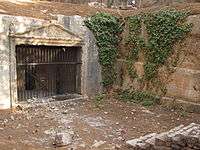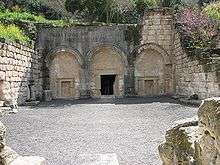Rock-cut tombs in ancient Israel
Hundreds of rock-cut tombs were constructed in Israel in ancient times. They were cut into the rock, sometimes with elaborate facades and multiple burial chambers. Some are free-standing, but most are caves. Each tomb typically belonged to a single, wealthy family. Bodies were laid out on stone benches. After a generation, the bones were moved to a bone chamber or, later, into ossuaries and the benches used for new burials. Rock tombs were the province of the wealthy; the common people were buried in the ground.
The earliest Canaanite cut-rock cave tombs date from 3100–2900 BCE, but the custom had lapsed a millennium before the earliest Israelite tombs, which date to the 9th century BCE in Jerusalem. There are a great many Jewish tombs dating to the Second Temple period, and others in the late Roman or early Byzantine period.
Bronze Age: Canaanite tombs
Early Canaanite I (3100–2900 BCE) period tombs are the earliest rock-cut tombs yet discovered in Israel; several have been found beneath the Ophel in Jerusalem. The custom had lapsed by the second millennium.[1]
Iron Age: First Temple period
In the Hebrew Bible
A number of rock-cut tombs are mentioned in the Bible. Possibly the first, called "Cave of Machpelah", was purchased by Abraham for Sarah from Ephron the Hittite (Gen. 23:20). Traditionally, this tomb, which may have been either a rock-cut or a natural cave, is identified with the Cave of the Patriarchs in modern Hebron. According to very old traditions, Abraham, Isaac and Rebekah, Jacob and Leah were also buried there (Gen. 25:9; 49:29–33; 50:12). The New Testament reaffirms this tradition: "Their (Jacob and his family) bodies were brought back to Shechem and placed in the tomb that Abraham had bought from the sons of Hamor at Shechem for a certain sum of money" (Acts 7:16).
Rock-cut tombs are also mentioned in the Book of Judges (Judges 8:32), the Second Book of Samuel (2 Samuel 2:32), and the Second Books of Kings (2 Kings 9:28, 21:26, 23:16, 23:30).
Jerusalem
The Silwan necropolis, the most important ancient cemetery of the First Temple period, is assumed to have been used by the highest-ranking officials residing in Jerusalem, the capital city of the Kingdom of Judah. Its tombs were cut between the 9th and 7th centuries BCE. It is located in the Kidron Valley across from biblical Jerusalem of the kings of Judah, in the lower part of the ridge where the village of Silwan now stands.[2] The architecture of the tombs and the manner of burial is different "from anything known from contemporary Palestine. Elements such as entrances located high above the surface, gabled ceilings, straight ceilings with a cornice, trough-shaped resting-places with pillows, above-ground tombs, and inscriptions engraved on the facade appear only here."[2] The stone benches on which bodies were laid out and the small square entrance doors are similar to those found elsewhere in Judah. Ussishkin believes that the architectural similarity to building styles of the Phoenician cities validates the Biblical description of Phoenician influence on the Israelite kingdoms.[2] There are three different types of tombs in the Silwan necropolis, each type concentrated in one specific area. Seven of the tombs feature gabled ceilings and extremely fine stonework. David Ussishkin describes them as "among the most beautifully rock-cut tombs known in the Jerusalem area even when compared with tombs of later periods."[2] In contrast with the extensive family tombs of later periods, these are for single or double burials, with only one of the seven having room for three bodies. Later destruction has effaced the original doorways.[2] A second tomb type described by Ussishkin has flat ceilings and one, two, or three chambers of well-dressed stone carefully squared into spacious rooms. One features a rear chamber of especially "impressive" scale and quality. There are tombs combining characteristics of the two described here above. The third type consists of just three "magnificent" monolith tombs, now located in the northern part of the village. These have been carved out of the cliff to create free-standing buildings above the underground burial chambers. Hebrew inscriptions survive on these three tombs; these are the only ancient inscriptions that survive in Silwan.[2]
Second Temple period
Primary burials
During the Hasmonean part of the Second Temple period, rock-cut tombs, not seen since the First Temple period, had a comeback among Judaeans, but were restricted to the elites.[3] At the beginning of the Hasmonean period, under the influence of Hellenistic burial customs from Marisa, members of the elite were buried in wooden coffins inside shafts known in Latin as loculi and in Hebrew as kokhim.[3] Later, in the area of Jerusalem, primary burials took place either in kokhim, or in arched niches known in Latin as arcosolia.[3]
However, the regular type of burial during the Early Roman period (c. 63 BCE-70 CE), used by the non-elite population, was done in trenches.[3] Trench burials were quite varied, with one or two bodies, either in primary or secondary burial, with even a case of an infant buried in a jar coming to light.[3] If such a simple grave was hewn into the rock, archaeologists speak of a cist tomb (Keddie 2019, p.227).[3]
Some support the theory that in the Galilee, rock-cut tombs only had a comeback after the destruction of Jerusalem and the influx of refugees from Judaea after 70 CE (Keddie 2019, p. 237).[3]
Secondary burials
Elite burials happened in two phases, the second burial consisting in collecting the bones after the decomposition of the body and placing them in specific places within the tomb - a procedure known as ossilegium.[3] During the early Hasmonean period at Jericho, the bones were placed back in the primary burial niches or on benches.[3] Around 20-15 BCE, Judaean elites started using ossuaries made of limestone, a custom that continued in the Jerusalem area until little after 70 CE (Keddie 2019, p.230).[3] The very large, monumental tombs of elite families from the Late Hellenistic period, often capped by pyramids or accompanied by impressive markers known as nefesh, are giving way in the Early Roman period to such enhanced by elaborate and refined facade relief decorations (Keddie 2019, p. 229).[3]
Jerusalem
During the Second Temple period, rock-cut tombs were built outside the walls of the city of Jerusalem in every direction,[4] but predominantly to the north and south of the city.[5] The tombs extend as far as 7 km from the city walls, with the more prestigious tombs located close to the city.[4]
The most elaborate group of tombs was in the Kidron Valley across from the Temple Mount. These include the Tomb of Benei Hezir with the adjacent so-called Tomb of Zechariah monument (actually not a tomb), and the Tomb of Absalom along with the Cave of Jehoshaphat located behind it.[5] Among the notable tombs are the Jason's Tomb, a large, elaborate, family tomb with multiple chambers and inscriptions in both Hebrew and Greek and the Tombs of the Kings, which is actually the tomb of Queen Helena of Adiabene and her relatives.[4] The elaborate Tombs of the Sanhedrin lie to the north of the city.[4] They were so called by later generations because the largest of them contains 70 chambers with burial benches, and the Sanhedrin had seventy members.[4] Each of the three tombs would actually have contained the burials of a single, multi-generational, wealthy family. They were constructed between the reign of Herod and the year 70.[4]

 The "Tombs of the Kings", believed to be the tomb of Queen Helene of Adiabene; 19th-century lithograph by William Henry Bartlett
The "Tombs of the Kings", believed to be the tomb of Queen Helene of Adiabene; 19th-century lithograph by William Henry Bartlett
Tomb of Jesus: Gospels and archaeology
The Gospel of Matthew mentions the newly rock-cut tomb of Joseph of Arimathea (Matthew 27:60).[6]
Proposed candidates for the tomb include the rock-cut chamber inside the Church of the Holy Sepulchre, the Talpiot Tomb, and the Garden Tomb.
Late Roman and Byzantine periods
Beit She'arim

The ruins of Beit She'arim in the Galilee preserve a vast necropolis with catacombs containing a large number of rock-cut Jewish tombs from the late 2nd to 6th centuries CE.[7][8]
References
- "Ancient Jerusalem's Funerary Customs and Tombs: Part Two", L. Y. Rahmani, The Biblical Archaeologist, Vol. 44, No. 4 (Autumn, 1981), pp. 229–235.
- The Necropolis from the Time of the Kingdom of Judah at Silwan, Jerusalem, David Ussishkin, The Biblical Archaeologist, Vol. 33, No. 2 (May 1970), pp. 33–46
- Keddie, Anthony (2019). Class and Power in Roman Palestine: The Socioeconomic Setting of Judaism and Christian Origins. Cambridge University Press. pp. 227–237. ISBN 978-1-108-49394-9. Retrieved 12 April 2020.
- "Ancient Jerusalem's Funerary Customs and Tombs: Part Three Ancient Jerusalem's Funerary Customs and Tombs: Part Three, L. Y. Rahmani, The Biblical Archaeologist, Vol. 45, No. 1 (Winter 1982), pp. 43–53,
- Hachlili, Rachel. Jewish Funerary Customs, Practices and Rites in the Second Temple Period, pages 1-2, 30-36. Boston: Brill, Leiden, 2005.
- "Mark 15:46". Bible.cc. Retrieved 2013-04-25.
- The Oxford encyclopedia of Archaeology in the Near East, Volume 1, pp. 309–311.
- Stern, Karen B. (2011). Galor, Katharina; Avni, Gideon (eds.). Reading Between the Lines: Jewish Mortuary Practices in Text and Archaeology (PDF). Unearthing Jerusalem: 150 Years of Archaeological Research in the Holy City. Pennsylvania State University Press. p. 101. ISBN 9781575062235. Retrieved 12 April 2020.
External links
